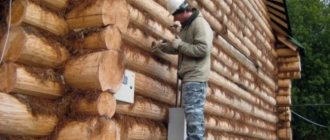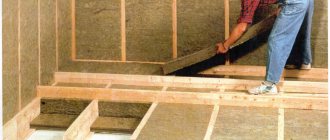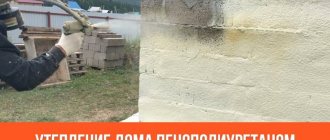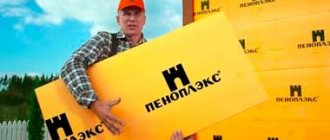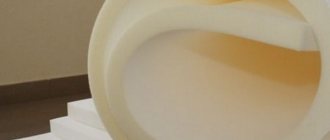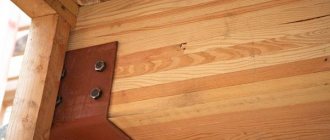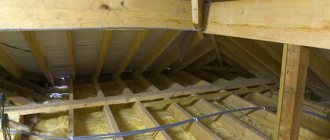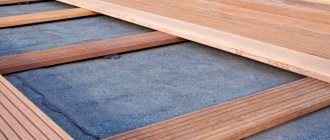The law of physics, according to which heated air rises, no one can challenge. This law applies equally to any building: brick, wood, concrete. Therefore, insulating the ceiling in a wooden house for its residents means saving considerable money on its heating - after all, it has long been known that a properly built log house retains heat inside the house much more effectively than brick or concrete walls.
Insulation “under a microscope”
Insulating the ceiling in a private house is a difficult process that requires special attention and calculation. The fact is that in such a structure, heat leaves the room faster, which means it is necessary to take care of its safety. In addition, special materials intended for this “mission” must meet the following requirements:
There is a similar article on this topic - How to insulate a wooden house from the inside and outside?
- Economical.
- Environmentally friendly.
- Vapor barrier.
- Soundproofing.
- High level of fire protection.
- Moisture resistance.
To insulate the ceiling in a private house, you can use several types of material :
- Sawdust.
- Styrofoam.
- Minvata and others.
In turn, they can be divided into:
- Bulk.
- Fibrous.
- Leafy.
How to insulate a ceiling with your own hands using stone wool, video:
In addition, it is necessary to take into account the quality and type of material from which the building is built, since the insulation of the ceiling in a wooden house will be different in its technology if you need to perform the same manipulations in a brick building .
The main types of buildings (materials for construction) that require additional insulation:
- Brick.
- Tree.
- Foam block.
To achieve maximum results, you need to pay a lot of attention to this process and try to find the best option that 100% meets the requirements both in price and quality.
As part of the work, it is necessary to use high-quality thermal insulation materials, which turn into a kind of barrier between the ceiling and warm air.
As a result, heat loss in the room is reduced, and it becomes possible to enjoy coziness, comfort and save on heating the building.
Types of installation
There are 2 methods of installing insulation materials:
- From above - on the floor of the attic. This method is less expensive.
- Insulation of the ceiling from the inside - on the surface of the ceiling from the side of the room. Requires the use of finishing materials. This method is also more expensive to implement.
Insulation of any type helps to retain warm air in the room, forcing it to circulate throughout the space of the rooms, thus preventing it from escaping outside.
Backfilling methods
The process of filling any insulation is the same: the material is poured into the cavity and compacted. It is recommended that the issue of insulation be addressed immediately when designing a house. If there are no internal cavities for filling in insulation, layers are made using PVC panels or plasterboard.
A good option is when the insulation is poured between facing and ordinary bricks, between internal and external masonry. There may be ribs inside so that it is well distributed. Thanks to loose thermal insulation, the walls do not need to be made thick, which saves costs. There are ready-made concrete products on sale - slabs, inside of which there are already cavities filled with expanded clay; they retain heat 50% better than ordinary ones.
Options
For floors, these methods of insulation with bulk components are used. The first option is fill-in (or loose) insulation on the joists. Joists are made on the floor on posts, skull blocks are nailed, then flooring is made of boards. A vapor barrier is placed on the flooring and expanded clay is poured. Further, if necessary, the next layer of thermal insulation, on it - screed, rough wood flooring.
The second option is an embankment on top of a concrete slab. An option for low-quality housing - Khrushchev, for example - when it is possible to raise the floor level. The floor covering is removed, waterproofing is laid, expanded clay is poured onto it in a layer of 5 - 10 cm. Then you can put a mesh for reinforcement, and a rough screed is made on it - the basis of the finishing floor covering. A vapor barrier is laid on top of the expanded clay cushion, and another layer of insulation is placed on top of it.
How to choose the type of insulation?
Very good question. More recently, 10–20 years ago, there was a widespread practice when elementary porous materials, sawdust, slag, grass, and then expanded clay were simply poured onto the floor of the attic. Of course, this method was the cheapest possible, and the necessary heat insulators were difficult to find, no matter how hard you wanted.
Even expanded clay, which is the most worthy “candidate” on this list, is many times inferior to modern technologies, which retain heat in the house by 40–50% more. The difference is noticeable, so it makes sense to talk about what type of insulation should be chosen in the 21st century!
Features of raw materials
Having familiarized ourselves with the main types of bulk insulation, we can summarize that it is always secondary raw materials. It is produced by processing various wastes ranging from cellulose to minerals. Bulk heat insulators in most cases are pure environmental raw materials. Their common drawback is the need to create a facing partition: the insulation is poured between it and the main ceiling, for example, a wall.
Insulation with sawdust
Sawdust insulation is one of the most affordable and popular solutions. Sawdust is the cheapest method of insulation , requiring special attention, because this material is potentially fire hazardous. To do this, an “option” such as material processing is added to the technique, which increases the protection of sawdust.
Definitely, to the question of whether it is possible to insulate the ceiling with sawdust, the answer will be positive, but you need to take into account some nuances.
There are several main disadvantages of such a heat insulator:
- Rodents.
- Fire hazard.
Of course, before applying the material, it is necessary to calculate the thickness of the heat insulator. The volume of sawdust depends on factors such as the purpose of the building (basement, bathhouse, attic, room); it is necessary to take into account the climatic conditions in which the house is located (the more severe the cold, the thicker the sawdust insulation).
The binding elements for such insulation are cement and clay.
Ceiling insulation technology using sawdust:
- The ceiling is covered with special parchment.
- Boards and floors are treated with fire retardants.
- Prepare a mixture of water, cement and sawdust.
- Pouring liquid insulation.
Before preparing the solution, sawdust is mixed with lime or gypsum, which increases the fire safety level of the material and makes it unsuitable for rodents.
Externally, this heat insulator is very similar to wood concrete.
Advantages of sawdust insulation:
- Reliability.
- Durability.
- Economical.
- Moisture resistance.
- Easy to install.
The main disadvantage of this type of insulation is the fact that in the future the attic space will become unsuitable for use due to its fragility and vulnerability.
Loose thermal insulation ecowool
Ecowool was developed as part of a waste recycling program.
This type of insulation was developed in Europe as part of a recycling program. That is, the main goal is to usefully recycle waste. It is made exclusively from newspapers; no more than 10% cardboard is allowed. To prevent ecowool from burning, microorganisms from growing in it, and mice not gnawing on it, borax and boric acid are added to the detailed newsprint.
It is used as bulk insulation for floors and walls, installation is carried out using dry and wet methods. The density when blown by machine is 65 kg/m in the wall. cube, on floors 45 kg/m. cube, density for manual laying - up to 90 kg/m. cube Thanks to fire retardants, the material does not burn, but smolders successfully.
The service life of ecowool produced in the Omsk and Tomsk regions is 10–12 years. Western manufacturers claim that the material will last 50 years. But they give such forecasts based on the climatic conditions of their region, where temperature differences are smaller and, accordingly, less moisture settles in the insulation (due to the dew point). For Russia, with its cold and humidity, these forecasts are unlikely to come true.
The thermal conductivity of ecowool is 0.037–0.042 W/m*C. It easily absorbs moisture and releases it just as easily.
When wet, it becomes heavier, which leads to shrinkage, which is inevitable. In fact, ecowool has nothing to do with environmental friendliness. It is simply stuffed with chemicals and we do not recommend using it.
Ceiling insulation with foam plastic
Today, ceiling insulation with foam plastic is also in demand. This material has enormous advantages compared to other heat insulators. Many craftsmen give a clear answer to the question of what is the best way to insulate the ceiling.
Of course, its installation requires compliance with some important elements, among which is maintaining the tightness of the joints .
Only by making sure that they are correct can you be sure that the house will be 100% insulated. To do this, use polyurethane foam, which helps take care of this problem. This material has a number of distinctive qualities :
- High level of thermal insulation.
- Waterproof.
- Soundproofing.
- Lightweight design that will not place significant load on the floors.
- Easy to install.
- Economical.
- Environmentally friendly.
- Unpretentiousness to external conditions.
- Does not cake and retains its shape for a long time.
- High efficiency.
- Practical for use in many types of homes.
- Strength.
The ideal solution would be a combined insulation method, which combines the properties of two materials: polystyrene foam and mineral wool .
They complement each other perfectly, creating an ideal barrier to warm air. This combination of polystyrene foam with mineral wool helps make the insulation reliable, however, there are also disadvantages in this section.
Disadvantages of polystyrene foam:
- The material is, of course, inexpensive, but compared to some other heat insulators, it is still more expensive .
- It will be more difficult to adjust it to the size of the surface to be covered , which creates some difficulties and discomfort during installation, especially if we insulate the ceiling ourselves.
- Low level of fire safety.
- It can harbor rodents , which means you need to take care of this problem by purchasing the necessary medications.
In addition, before installing it on the floor or ceiling, it is necessary to bring the surface into proper shape, which wastes extra time.
So, is it possible to insulate the ceiling with polystyrene foam ? Yes, but it’s worth considering all its pros and cons, just like when working with any other material.
Helpful advice: It is not recommended to compress the insulation under any circumstances. This can be explained very simply: the effect of heat conservation is that the air bubbles that “live” inside prevent heat transfer.
Video description
Which insulation divides heat better, watch the video:
Advice! When working with penoizol, it is recommended to wait until it hardens completely; it has a slight shrinkage that will have to be compensated to prevent the formation of voids.
The process of thermal insulation of the ceiling with foam insulation Source lestorg32.ru
Ceiling insulation with mineral wool
Mineral wool is an excellent heat insulator, which is a good competitor even to polystyrene foam. It is often used when insulating the ceiling from the inside of a room, especially a wooden house. This material is also in the category of the most popular and popular insulation materials. So, if you are just thinking about how to insulate the ceiling, this information will be useful to you.
The best way to use it is considered to be a combination with polystyrene foam , which helps to achieve excellent results, not just reducing heat costs, but simply eliminating them in nature. This “mixture” will help you save money and create a very cozy family “nest”.
Mineral wool has a number of advantages , which include the following:
- Low vapor permeability.
- Economical. You can cheaply insulate the ceiling.
- Easy to install.
- Environmentally friendly.
- High level of fire safety.
- Doesn't rot.
- It is an environment in which insects and rodents cannot grow.
- Excellent noise and sound insulator.
Of course, mineral wool is not without its disadvantages , which include:
- Low moisture resistance.
- The material tends to cake , which means it can quickly lose its thermal insulation qualities.
- There are difficulties during installation , violating the quality of which, you can lose almost 40% of the heat in the house.
- Requires extra costs for the purchase of additional materials to enhance the aesthetic appearance of the room.
Today you can find many different types of mineral wool on sale, which are low in cost and are excellent for use in various types of buildings.
Foam
Among the common foam insulation materials, materials based on polyurethane and polystyrene (penoizol) are most often used.
- Polyurethane foam - a relatively new and expensive insulation material, its structure resembles foam plastic. Moisture resistant, retains performance properties for more than 50 years, low thermal conductivity (0.02 W/mK). Disadvantages: high cost (from 20,000 rubles per 1m3), application requires special equipment.
- Penoizol. In fact, this is ordinary foam plastic, the main difference is a seamless monolithic coating.
The process of applying penoizol to a cold attic
Thermal conductivity is almost twice as high as that of polyurethane foam - 0.42 W/mK. It does not rot, does not bloom, rodents and other living creatures do not grow in it. It is airtight, so it should not be used to fill the wooden floor of the attic. Relatively high toxicity does not allow indoor use. Price from 2500 RUR per m3.
Features of ceiling insulation in a wooden house, made of foam block and brick
Brick is the most common material from which both multi-storey buildings and private houses are built. Many types of this material are designed for different climatic conditions, which allows people to choose the best option and find a solution when building a home.
Unfortunately, this material is not very practical as a heat insulator, which requires people to solve this problem by installing additional insulation. In this regard, it is necessary to approach this issue with great precision and attention. The insulation system will be different for houses made of hollow brick or solid brick, and so on.
Before purchasing a heat insulator, you need to calculate its quantity, which will depend on a combination of many conditions and factors.
Foam block - this heat insulator has an optimal price and high strength, which means it makes excellent houses. This material combines all the best qualities of brick and wood, which helps create a comfortable indoor climate. In such buildings, you need to take care of only one thing - protecting the walls from moisture and condensation. To do this, it is necessary to cover them with heat insulators that are moisture resistant.
Roof roofing with corrugated sheeting. - there is more useful information here.
Important! It is necessary to insulate houses made of foam blocks only from the outside, since mineral wool or polystyrene foam will not allow the walls to warm up, which will significantly reduce the temperature in the room.
In addition, the surface of the building from the street will need to be covered with a vapor barrier and a screen installed, which will not only provide an aesthetic appearance, but will also protect the heat-insulating materials.
Depending on the climate zone and the type of foam concrete, it is necessary to correctly calculate the thickness of the insulation, which will help not only save money on the purchase of materials, but also on heating the premises. We recommend that you study in advance all the nuances of how to properly insulate a ceiling with your own hands in order to avoid mistakes.
You will be interested in this article - Seam roofing: installation instructions, ventilation.
Summarizing
If we summarize all of the above, then we can draw one important conclusion: for optimal and more complete thermal insulation, it is necessary to use combinations of materials that will complement each other, creating a reliable shield for warm air.
Option for insulating the ceiling with padding polyester:
The most common options are insulation with penoplex, expanded polystyrene, foam, isospan, polyurethane foam, sawdust with clay, slag, ecowool.
Loose penoizol
Penoizol flakes have a random shape.
In appearance, penoizol looks like foam chips, but if you look more closely, the difference is obvious. Despite the visual similarity, these are two completely different materials. Penoizol is more reminiscent of snow flakes, it does not have an ideal ball shape, this material is softer. Penoizol is used as fill-in insulation for walls and horizontal ceilings. In addition, it is also available in sheets, but is mainly used in liquid form. Unlike polystyrene foam, penoizol:
- does not burn;
- does not smoke;
- allows moisture to pass through, but does not absorb it.
The thermal conductivity characteristics of both materials are almost equal.
Penoizol backfill insulation for walls is made from resin. The quality of the material primarily depends on the quality of the resin used for production.
First, the liquid substance is poured into blocks, about a meter by meter. Then the blocks are cut into sheets, and only then the sheets are crumbled. Installation is carried out using a blowing machine or manually. When working, you need to control the degree of density of the material.
Choose by cost
The cost of insulation changes very quickly. Therefore, as an example, we present a small plate with the cost of some popular insulation materials.
| Mineral wool | Amount in a package | Thickness, mm | Cost in rubles | Cost in dollars |
| TechnoNIKOL Greenguard | 4 | 100 | 380 rubles | 6,5 |
| Paroc Extra | 8 | 100 | 1000 rubles | 17,2 |
| Isover Classic cooker | 10 | 100 | 525 rubles | 9 |
| Izovol St-50 | 4 | 100 | 400 rubles | 6,9 |
| Styrofoam | Amount in a package | Thickness, mm | Cost in rubles | Cost in dollars |
| Knauf Therm | 10 | 100 | 2200 rubles | 38 |
| TechnoNIKOL Carbon Eco | 4 | 100 | 2600 rubles | 45 |
| Penoplex Comfort | 18 | 20 | 1200 rubles | 20,6 |
Blowing polyurethane foam will cost 200-300 rubles per square meter (labor and material). Ecowool will cost 3000-4000 rubles per cubic meter. The cheapest insulation is probably sawdust, 300-500 rubles per cubic meter. Using the above figures, you can calculate the approximate cost per square meter of insulation.
Roofs
Insulation of a pitched roof with expanded clay is rarely carried out, but the technology is simple:
- boards are packed along the bottom of the rafters, forming a plane on which the insulation will be poured;
- A vapor barrier film made of polyethylene is laid overlapping. It has several functions: vapor and waterproofing, preventing small fractions of pellets from spilling through the cracks between the boards;
- Ceramic granules are poured over the film in an even layer;
- the thermal insulation layer is covered with a vapor barrier membrane;
- a counter-lattice is filled to create a ventilation gap;
- boards are attached on top of the counter-lattice to secure the roofing material;
- the roof is being installed.
Manufacturers
On the market you can find materials for insulation of domestic production, as well as insulation from the USA, Finland, Germany, France and other countries.
The following brands are available:
- TechnoNikol;
- Knauf;
- Isoroc;
- Isover;
- Paroc;
- Rockwool;
- Ruspanel;
- Soudal;
- Tytan;
- Ursa;
- Akterm;
- Penoplex;
- Penofol;
- Tepofol;
- Tilit;
- And others.
Go to any well-known online store and use filters to look at the characteristics of each individual product.
As you can see, there are very different methods of insulation, but price always remains an important issue.
Foundation
The foundation needs thermal insulation to prevent annual temperature fluctuations. The technology for its protection by filling with expanded clay is as follows:
- A trench is dug around the finished foundation with a depth corresponding to the amount of soil freezing. The trench width is at least 50 cm.
- In the resulting cavity, formwork is placed from available materials (boards, slate sheets).
- Waterproofing work is carried out on the bottom and side surfaces (film, roofing felt, etc.).
- Expanded clay gravel is filled to zero level and compacted. The surface is leveled.
- The insulation on top is also insulated from moisture.
- Then a blind area is made around the foundation or a thin layer of soil is poured.
